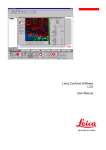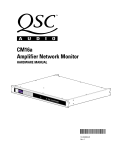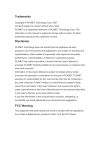Download Billion BIPAC 2073 User manual
Transcript
BiPAC 2073 R2 HomePlug AV 200 Ethernet Adapter BiPAC 2074 R2 HomePlug AV 200 Ethernet Bridge with AC Pass-Through User Manual Firmware Version 4.0.1 Last revised on Mar 2010 Safety Warnings 1. Do not use the adapter in high humidity or high temperature environment. 2. Do not open or repair the case yourself. 3. Avoid using this product and all its accesories outdoor. 4. Place the adapter on a stable surface. 5. Only “HomePlug AV” compliant Powerline Communication (PLC) adapter for remote access is necessary. 6. Plug your BiPAC HomePlug AV device directly to the AC outlet on the wall. It is best to avoid using extension power cable as it may possess noise filter or surge protector functions that may cause interference that may impact the performance of the device. 7. Use only IT products (eg. fax machine, router) that are below 6Amp for the built-in AC outlet of BiPAC 2074 R2. Table of Contents Chapter 1: Product............................................................................. 1 Introduction.................................................................................. 1 Features....................................................................................... 2 Chapter 2: Installing the Router........................................................ 3 Package Contents........................................................................ 3 BiPAC 2073 R2....................................................................................3 BiPAC 2074 R2....................................................................................3 Important note for using this adapter..........................................................4 Device Overview.........................................................................................5 Hardware Installation (For separated plug clip type only)...........................7 Connecting the HomePlug Adapter.............................................................9 Power Connection................................................................................9 LAN Connection.................................................................................10 AC Pass-Through Connection........................................................... 11 Networking Setup...............................................................................12 Setup Utility........................................................................................13 Quick Start (Setup Powerline Network)...................................... 14 Push Button usage.............................................................................14 Application Scenarios........................................................................14 Powerline Network Illustration............................................................16 Chapter 3: Installation...................................................................... 17 Utility Installation........................................................................ 17 BiPAC HomePlug AV 200 Utility Installation............................... 18 Chapter 4: Configuration................................................................. 24 Accessing BiPAC HomePlug AV 200 Utility................................ 24 BiPAC HomePlug AV Utility........................................................ 25 Main Tab............................................................................................25 Privacy Tab........................................................................................29 QoS Tab.............................................................................................30 Diagnostic Tab...................................................................................32 Firmware Download Tab....................................................................34 About Tab...........................................................................................35 Firmware Upgrade.............................................................................36 Chapter 5: Troubleshooting............................................................. 39 Appendix: Product Support & Contact........................................... 40 Chapter 1: Product Introduction BiPAC HomePlug AV 200 is a networking device that utilizes the existing wiring system as a path to transmit data signal through the inter-conversion between digital and analog signal. With this functionality, HomePlug AV devices can be plugged into an AC outlet to draw power and at the same time establishing a network connection between two or more Ethernet devices. BiPAC HomePlug AV 200 can be used to bridge any Ethernet device to your Powerline network in your home or office. With this technology, Ethernet devices in your home or office can equally share high speed data transmission rate without the need to spend excessive time and money installing expensive Ethernet cable. It can be plugged into an Ethernet port on a router to equip a network with powerline capabilities and take advantage of the router features. HomePlug AV device can also be plugged directly into a cable or DSL modem that allows instant internet access over home Powerlines to each computer equipped with a HomePlug AV certified Powerline network adapter. BiPAC HomePlug AV 200 makes high-speed modem sharing as fast and simple as plugging the devices in the wall. 1 Features 1. Physical layer data rate up to 200Mbps over existing Powerline. 2. Uses powerline technology that takes advantage of the unused bandwidth of the electrical wiring in the home. 3. Ideal for Triple Play applications such as IPTV, VoIP telephony and high-speed Internet access. 4. Support 10/100 (MDI/MDIX) Ethernet switching. 5. Compliant with the HomePlug Powerline Alliance Industry specification HomePlug AV. 6. Power supplier design inside. 7. Ideal for Residential Users. 8. Power Saving mode: When PC / other Ethenet devices are completely power off or when there is no Ethernet cable connected, HomePlug device will automatically enter power saving mode which will help to reduce power consumption. 9. Noise Filter (only available in BiPAC 2074 R2): Allow the filtering of noise which may be generated by some electrical appliances such as vacuum cleaner and hair dryer to prevent possible interference with HomePlug AV network. 2 Chapter 2: Installing the Router Package Contents BiPAC 2073 R2 • BiPAC 2073 R2 HomePlug AV 200 Ethernet Adapter • Quick Start Guide • CD (containing user manual and QSG) • Ethernet (CAT-5 LAN) cable BiPAC 2074 R2 • BiPAC 2074 R2 HomePlug AV 200 Ethernet Bridge with AC Pass Through • Quick Start Guide • CD (containing user manual and QSG) • Ethernet (CAT-5 LAN) cable 3 Important note for using this adapter 4 Device Overview The LEDs and Buttons BiPAC 2074 R2 BiPAC 2073 R2 Power LED PLC LED AC Power Outlet / AC Pass-through (only available in BiPAC 2074 R2) ETH LED SYNC Button Reset Button Ethernet Port Power Plug The Description of each labeled part is described in the table below. AC Outlet / AC PassFiltered AC Pass-through available for electrical devices with Input: through (only available 100~240V AC, 50~60Hz, 6Amp (Maximum). in BiPAC 2074 R2) Power LED Lit when the device is power on. Blinking briefly when the device enters power saving mode. Blinking when pushing the SYNC button. Lit off when power is off. PLC (Powerline Link/ Act) LED Lit green when the power line connection is established. Blinking quickly when data is transmitted or received via power line. Note: When the device acts as a CCO (Central Coordinator), PLC LED will light steadily. There should be at least one CCO in your powerline network. Blinking after SYNC button is pushed (see SYNC Button descripted below). Lit when connected to an Ethernet device. Blinking when data is transmitted or received via Ethernet port. ETH (Ethernet Link/ Act) LED SYNC Button Reset Button Ethernet Port Used to establish a LAN network with other power line devices. Push this button for 1~3 second(s) and release it to set device enter the power line SYNC state. Press this button to for 1~3 second(s) to reset device to factory default settings. Connect the HomePlug AV device with an Ethernet device (e.g. computer, router, hub/switch , IP pone, IPTV set-top-box, gaming consoles…), using the RJ-45 Ethernet cable included. Power Plug / AC Power Plug into an AC outlet for power supply and to build a powerline Cord network with other HomePlug AV devices. 5 The Rear Side and Look BiPAC 2073 R2 (For separated plug clip type only) BiPAC 2074 R2 Clip Socket: Install the clip into this socket 6 Power Plug Hardware Installation (For separated plug clip type only) Refer to the following diagrams and direction to install the clip with BiPAC 2073 R2: Example 1: EU clip. • Please check the lock instruction on your clip. • If you got the “Triangle Lock”, refer to right diagram. 7 Example 2: UK clip. • Please check the lock instruction on your clip. • If you got the “Circle Lock”, refer to right diagram. 8 Connecting the HomePlug Adapter It is easy to connect the device simply by performing the following instructions: Power Connection BiPAC 2073 R2 Plug the Homeplug AV 200 Ethernet Adapter into the wall outlet/socket. BiPAC 2074 R2 Plug the embedded AC power cable to the wall outlet/socket. Note: Plug/socket, power cable and input voltage/frequency may vary from country to country. 9 LAN Connection Connect the supplied RJ-45 Ethernet cable to the Ethernet port on HomePlug AV 200 Ethernet bridge/adapter and the other side to the device’s Ethernet interface. 10 AC Pass-Through Connection BiPAC 2074 R2 only Plug IT electrical devices (e.g. ADSL router, Set-to-box, notebook, etc.) into the built-in AC passthrough with an embedded low-pass filter to prevent electrical noise from interfering on your powering network. 11 Networking Setup Refer to the following steps: 1. Connect a network cable to the adapter or bridge and then plug the device into a power socket. BiPAC 2074 R2 BiPAC 2073 R2 2. Then connect the device to a PC, modem, router or set-top-box. BiPAC 2074 R2 BiPAC 2073 R2 3. Create a secure network by simply pushing the SYNC button for 1~3 seconds.Please refer to Quick Start (Setup Powerline Network) section for more detail description. BiPAC 2074 R2 BiPAC 2073 R2 12 Setup Utility After you complete the hardware installation, insert the CD-ROM to the CD-ROM drive to perform Setup Utility for network configuration. The Setup Utility will auto-run. Follow the step-by-step configuration wizard, the utility will guide you complete the basic network configuration. See Utility Installation section. 13 Quick Start (Setup Powerline Network) Push Button Usage SYNC Button is used to add a HomePlug device to a powerline network or remove it from current pwoerline network. There are 2 types of SYNC Button trigger state: 1. Joining a Network: Press the SYNC button on the device for less than 3 seconds. Press the SYNC button on another device connected to the same medium for less than 3 seconds. Wait a few seconds for the two devices to form a network. A join operation can be cancelled by pressing the SYNC button on the first device again, for less than 3 seconds, instead of pressing the SYNC button on the second device. 2. Leaving a Network: Press the SYNC button on the device for more than 10 seconds. Wait a few seconds for the device to reset and leave the network. The device is then free to join another HomePlug AV logical network. There are two role in Joining a Network. The "adder" is the device that gives a Network Name to another device. The "joiner" is the device that takes a Network Name from another device. When the two device have the same Network Name, they will form a HomePlugAV Logical Network. The role of "adder" or "joiner" is determined automatically by each device when the SYNC button is pressed. A device that belongs to an existing logical network will become an "adder". A device that does not belong to a network will become a "joiner". Only one "adder" and one "joiner" can participate in "Joining a Network" process at the same time. If both devices are "joiners", the device with the higher MAC address becomes the "adder" by default. Application Scenarios Scenario 1: A BiPAC HomePlug AV device A wants to form a network group with another BiPAC HomePlug AV device B It doesn't matter which SYNC button of the device is pressed first. Because device A and B are left from the original network, they are both "joiner" now. When "Joining a Network" process starts, the devices will determine which one is "adder" and the other one is "joiner" automatically. Example: 1. Press the SYNC button of device A for more than 10 seconds to make sure that it is detached completely from any possible network group. 2. Press the SYNC button of device B for more than 10 seconds to make sure that it is detached completely from any possible network group. 3. Press the SYNC button of device A for 1~3 seconds, you should find the Power LED blinks steadily signifying it is in “Joining a Netrwork” process. 4. Press the SYNC button of device B for 1~3 seconds, you should find the Power LED blinks steadily signifying it is in “Joining a Network” process. 5. Wait for the PLC LEDs of both devices lit steadily, you will now have these devices being in the same network group. 14 Scenario 2: A BiPAC HomePlug AV device wants to join an existing network group BC Device A wants to Joining a Network group "BC" currently consisting of device B and device C. Any devices within the "BC" group can become the "adder" and device A will be the "joiner". Example: 1. Press the SYNC Button of device A for more than 10 seconds to make sure that it is detached completely from any possible network group. 2. Press the SYNC button of device B or C of the BC network group for 1~3 seconds to turn it into “adder”, you should find the Power LED blinks steadily signifying it is in “Joining a Network” process. 3. Press the SYNC button of device A for 1~3 seconds to turn it into “joiner”, you should find the Power LED blinks steadily signifying it is in “Joining a Network” process. 4. Wait for the PLC LEDs of both devices lit steadily, you will now have device A joined with the network group BC. Scenario 3: A BiPAC HomePlug AV device A of network group AD wants to join an existing network group BC For a device which already belongs to a network group is to join with a different network group, that device has to be left from its current attached group first. Example: 1. Press the SYNC Button of device A for more than 10 seconds to leave from network group AD. 2. Then press the SYNC button of device (B or C) of network group BC for 1~3 seconds to turn it to “adder”, you should find the Power LED blinks steadily signifying it is in “Joining a Network” process. 3. Press the SYNC button of device A again for 1~3 seconds to turn it to “joiner”, you should find the Power LED blinks steadily signifying it is in “Joining a Network” process. 4. Wait for the PLC LED of both devices A and (B or C) lit steadily. Now you will have device A join the network group BC. 15 Powerline Network Illustration 16 Chapter 3: Installation Utility Installation The utility can be used on the following Windows platform: Windows 2000/XP/Vista/7. 1. Place the BiPAC HomePlug AV 200 Utility auto-installation CD into your CD-ROM/DVD-ROM drive. 2. Click on Utility for Easy Installation to install the utility. 17 BiPAC HomePlug AV 200 Utility Installation 1. After clicking on Utility for Easy Installation, the installation wizard will appear. Click Next. 2. You may define the location of the installation folder using the Browse button, however it is highly recommended that you use the default location. In addition, you can also choose to install HomePlug AV 200 Utility only for yourself or for all the users who share your PC. When all necessary items are properly selected, press Next to proceed. 18 3. Press Next to confirm and start the installation. 4. While the utility installlation is in progress, the system will automatically prompt you to install the WinPcap program in a separate window pop-up. Install this program in order for the utility to work well. 19 5. While the utility installlation is in progress, the system will automatically prompt you to install the WinPcap program in a separate window pop-up. Install this program in order for the utility to work well. 6. When the WinPcap installation window pops up, click Next to proceed with the installation. 7. Click on Next to proceed to the next step. 20 8. Read through the license agreement then click on I Agree button to accept the agreement term. 9. If you want the WinPcap driver run automatically when booting, please tick Automatically start the WinPcap driver at boot time. Then click on install to continue the installation. 21 10.When the WinPcap installation is done, click on Finish to close the window. 22 11.When the WinPcap installation is done, you will have also completed the BiPAC HomePlug AV 200 Utility installation as well. You may now click on the close button of the Utility installation window to finish the process. 23 Chapter 4: Configuration Accessing BiPAC HomePlug AV 200 Utility Once the BiPAC HomePlug AV 200 Utility Setup Wizard is installed, a shortcut will appear on the desktop. You can start the BiPAC HomePlug AV Utility by double clicking on the shortcut, or go through “start”→ “All Programs”→ “BiPAC HomePlug AV Utility” →“BiPAC HomePlug AV Utility”. 24 BiPAC HomePlug AV Utility Billion BiPAC HomePlug AV Utility consists of 6 screens accessed through 6 panel tabs. The 6 panels are Main, Privacy, Diagnostics, QoS, Firmware download and About located on the top left corner of the program for configuration convenience. Main Tab The Main Tab screen lists all the powerline devices that are connected to the host computer when the utility is running. The top left window panel shows all the local HomePlug AV devices that are connected to the computer’s NIC (Network Interface Card). Normally, only one device will be seen on the list. If there is more than one local device being connected, user can select the local device by clicking on it and then click the Connect button to its right to use it to connect to the internet. Once connected to the local device, the utility will automatically scan the power line periodically for other newly connected HomePlug AV devices. If no local HomePlug AV devices are discovered, the status area above the connect button will indicate with a message "NO HOMEPLUG ADAPTERS DETECTED". The bottom window panel displays all the HomePlug remote devices that are detected on the current network. The total number of remote devices connected on the same network can be found on top of the Remote device panel. Within this panel, you can also find some useful informations of each remote device such as its connection quality, transfer rate and MAC address. 25 The Network type (Public or Private) is also displayed based on the network status of the local device. The scan status option is displayed on the top right corner above the Remote devices panel showing whether the Autoscan function is turned ON or OFF. The following information is displayed for all devices that appear in the lower panel: Device Name: Show the default device name. User can change the name by either clicking on the rename button or by clicking on the name and editing in-place. An icon is usually shown with the device name. Password (*required when one needs to change the Private Network Name of the devices) This column is left blank by default. The password will be displayed only after it has been entered. For detail information on password setup, please refer to section on Password Setup Instruction. Each device comes with a unique password and it can be found at the back of the device itself. Quality: Display the overall quality of the data transmission rate. When the transmission rate is good, the number of line appear will increase. Rate (Mbps): Display the data transmission rate of each device. MAC Address: Show the Remote device MAC address. 26 Password Setup Instructions: This feature grants users the access level to change the Private Network Name of both the local & the remote HomePlug AV devices. Password is required if one is to change the Private Network Name of each devices within the powerline network in order for all devices to be able to communicate & synchronize with each other within the network. 1. To enter a password for a specific device, select the device and click on the Enter Password button at the bottom of the lower panel to call up the Set Device Password dialog box. 2. Then type in the password in the blank provided and press OK. Note: The password of each HomePlug device can be found at the back of the device. 27 3. If the password entered is not recognized or unacceptable, an error message box will pop up prompting user to change the password. Click OK then re-enter the password again. 4. If the password entered is correct, you will see that the password will be displayed next to the device. 28 Privacy Tab Privacy Tab allows user the convenience to manage the security of the private powerline network. In addition, user can also uitlize this feature to add a new HomePlug device to the private network instead of manually adding the device using its SYNC button. In order to add devices to the network through the utility GUI, Private Network Name of each device is required to be the same with the local device. All HomePlug AV devices are shipped using a default logical network name “HomePlugAv”. The Privacy tab screen allows user to change its default public network type to a private network by changing the network name (network password) of the device. The user can always reset the network type to HomePlug network (Public) by entering “HomePlugAv” as the network name or by clicking on the Use Default button. Note: Changing the network name to anything other than HomePlugAv will show the network type on the main screen as Private. Set Local Device Only button can be used to change the Private Network Name of the local device. If a new Private Network Name is entered, all associated devices seen on the Main Tab previously will no longer be present in the new network, thus causing the local device unable to communicate with other devices which were in the network previously. Set All Devices button is used to change the Private Network Name of all devices that appear on the Main tab screen whose Device Password had been entered correctly. For devices whose device passwords were not entered, this operation will fail and will report a failure message. 29 QoS Tab This function allows user the flexibility to manage the bandwidth usage for each HomePlug device. The higher the QoS priority the more bandwidth usage is allocated to that particular device. 30 To set the QoS priority of each device: 1. Click to select the type that you want to set the QoS priority. 2. In the Priority setting fields, click on Add/Modify button, then enter the IP address/MAC address and drag the Priority slider to either Low, Normal, Medium or High position. When the position of the slider is set, click Confirm to save the settings. You will see a new entry displayed in the table above. 3. After the setting of QoS is completed, click Apply to confirm the setting. 31 Diagnostic Tab The Diagnostics Tab screen shows System information and a history of all remote devices seen over a period of time. This screen is available for OEM/ODM Customization. The Upper panel shows technical data concerning software and hardware present on the host computer which were used for communication via HomePlug device on the Powerline network. The data includes the following: • Operating System Platform/Version • Host Network Name • MAC Address of all NICs (Network interface card) connected to the host • Identify versions of all Driver DLLs and Libraries used (NDIS) and optionally • MAC Firmware Version • MAC addresses of all devices connected locally to the host • Version of the Configuration Utility • Microprocessor 32 The Lower panel contains a history of all remote devices seen on the computer over a certain period of time. All devices that were on the powerline network are listed here along with a few other parameters. Devices that are active on the current logical network will show a transmission rate in the Rate column; devices on other networks, or devices that may no longer exist are shown with a “?” in the Rate column. The following remote device information is available from the diagnostics screen: • Device Alias Name • Device MAC Address • Device Password • Transfer rate • Device Last Known Network name • Vendor name • Date device last seen on the network • MAC Firmware version The diagnostics information displayed may be saved as a text file for later use, or it can be printed for reference. Devices, which are not part of the network anymore, can be deleted using the delete button. A warning window will pop up requesting for a confirmation when we try to delete a device which password has been entered. 33 Firmware Download Tab This function gives users the convenience to download the free bundled Firmware Upgrade tool from Billion website. Thus, with this feature, users can always keep their PLC Utility updated with the latest firmware. To Download the Free Bundled Firmware Upgrade Tool 1. Click on the Download Page button, you will automatically link to the Firmware Upgrade Tool webpage on Billion website. 2. Browse to the bottom of the page, then look for the firmware that corresponds to your HomePlug model. Then click on the firmware icon to download the tool. 3. Once you have saved your download, you may run the firmware upgrade tool. For firmware upgrade, please refer to the Firmware Upgrade section for more detail. 34 About Tab The About screen shows the software version. Under the Preferences panel, user can check the AutoScan box to turn on the Auto Scan function or check off the box to turn off the Auto Scan function. 35 Firmware Upgrade Firmware upgrade allows users to keep their HomePlug Utility application to the most updated feature. This firmware upgrade tool is designed to provide user the most user friendly application that makes firmware upgrade process easy and fast. Firmware Upgrade Instructions: 1. Download the firmware upgrade tool (.zip file) from Billion website then unzip the file. 2. Locate the Firmware upgrade icon then double click on it to initiate the firmware upgrade tool. Then click on the install button. 36 3. When the firmware upgrade application starts, it will automatically scan for all available LAN cards on the computer and the HomePlug AV devices connected to it. The “Device Infomation” part will display the firmware version and MAC address of the local HomePlug device. Note: You can also select the LAN card manually from the drop-down list. 4. Press the Firmware Upgrade button to start the upgrading process. A Information dislog will pop up, click OK to continue. 37 5. When upgrading is finished, a dialog will pop up to inform you. Click Yes to use the program or No to exit. 38 Chapter 5: Troubleshooting If your router is not functioning properly, please refer to the suggested solutions provided in this chapter. If your problems persist or the suggested solutions do not meet your needs, please kindly contact your service provider or Billion for support. Problems with the device Problem Suggested Solution I can not start my HomePlug device. Please check your power supply is working. HomePlug device operates from the power supplied by the home electrical wiring and can not operate without a working power supply. My Homeplug device is unable to This may due to the accidental change of the Network detect my other HomePlug device. Name. Access the HomePlug AV Utility and select the Privacy Tab. Enter the password “HomePlugAv” (Case Sensitive) in the blank provided. Then press the “Set to Local Device Only” button. Repeat the same procedure to the other HomePlug device. 39 Appendix: Product Support & Contact If you come across any problems please contact the dealer from where you purchased your product. Contact Billion Worldwide: http://www.billion.com Billion Product Registration Billion is committed to before and after sales customer services. You will get the most out of your Billion’s products after registration. Please register online at www.billion.com/register to receive valuable services and support. MAC OS is a registered Trademark of Apple Computer, Inc. Windows 98, Windows NT, Windows 2000, Windows Me, Windows XP, Windows Vista and Windows 7 are registered Trademarks of Microsoft Corporation. 40





















































